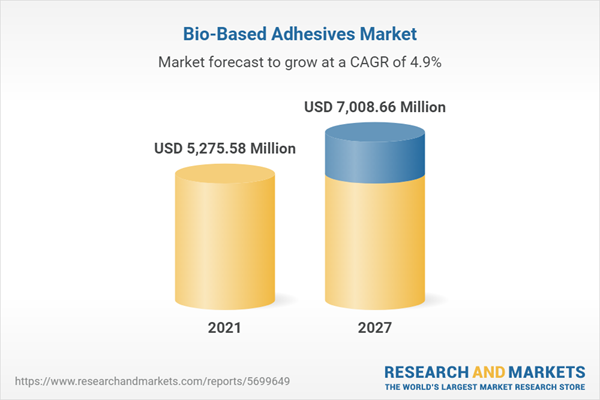Speak directly to the analyst to clarify any post sales queries you may have.
Globally, the demand and adoption of bio-based adhesives are increasing significantly due to several reasons, such as the increasing environmental concerns to reducing carbon footprint, reducing dependency on fossil fuels, and the existence of strong regulatory bodies. Regulatory bodies such as the United States Green Building Council, California Air Resources Board (CARB), and European Union have set the regulations and standards such as REACH, CLP, and the circular economy initiative that mandate the use of green adhesive across various applications. The existing and upcoming demand can be broadly classified into product type and application segments. The established bio-based adhesives markets of Europe and North America are expected to witness high demand for bio-based adhesive products during the forecast period due to the strong regulatory landscape for the bio-based product and unprecedented growth across the packaged food, pharmaceutical, furniture, and residential and non-residential construction industries due to the surge in private investment. Thus, this offers vendors many opportunities during the forecast period.
MARKET TRENDS & DRIVERS
Escalating Demand from Packaging Industry
- Increasing purchasing power, an increasing pace of urbanization, rapid growth of the e-commerce industry, and expanding population are driving the packaging industry market worldwide. The growth is expected to generate significant demand for bio-based adhesives products because it offers strong bonds and adhesion for manufacturing corrugated packaging, paperboard, and case and carton. Such factors create a positive impact on the bio-based adhesives market. Furthermore, bio-based adhesives also offer transparent packaging while assisting manufacturers in meeting operational budgets and enabling manufacturers to meet the rising demand for antiviral & antibacterial packaging.
Rising Sustainability Aspect
- Sustainability has become a significant concern for the consumer and industry as well. It is an evolving trend in the industrial and manufacturing sectors. In the past, adhesives were formulated from fossil fuel-based chemicals such as urea-formaldehyde, Methylene diphenyl diisocyanate, and phenol. Today, however, with increasing demand for green adhesives, companies are developing environment-friendly production processes and using renewable resources to fulfill the increasing demand for bio-based adhesive that promotes sustainability in the bio-based adhesives market. Production of adhesives from renewable feedstock is helping various industries in reducing their carbon footprint. Therefore, industries such as paper & packaging, OEMs, construction, and woodworking have decided to implement strategies promoting sustainable development so that companies can maximize profits while adding value to society.
MARKET RESTRAINTS
Stiff Competition from Low VOC Adhesive
- The major challenge faced in the global bio-based adhesives market is the high dominance of low VOC adhesives. Low VOC adhesive is user-friendly as a bio-based adhesive because, during its formulation, no safety measure is required. It is environmentally friendly and does not risk human or aquatic life by releasing toxic or odorous fumes. In addition, stringent environmental regulation mandated by the United States Environmental Protection Association (USEPA), Leadership in Energy and Environmental Design (LEED), and the European standards of EN 16785-1 verifies bio-based content of the product are also driving the demand for low VOC adhesive products.
SEGMENTATION ANALYSIS
INSIGHTS BY FEEDSTOCK
Sugar is one of the essential components in the global bio-based adhesives market under the feedstock segment. It generally includes starch, cane, and beet. The segment is expected to hold the largest global market share and will reach USD 3.87 billion by 2027. The global glycerol bio-based adhesives market was valued at USD 1,520.71 million in 2021 and emerged as the second-largest segment in the market, with a revenue share of 28.83%. Glycerol is the most important feedstock used in the adhesive industry, not only as a binding agent but also as a sustainability. Vegetable oils and saponification of oils & fats are used to produce glycerol. It is a versatile compound due to its chemical properties and environmental benefits, thus effective in synthesizing polymers and adhesive products.Segmentation by Feedstock
- Sugar
- Glycerol
- Oil & Fats
- Biogas
- Others
INSIGHTS BY APPLICATION
Based on application, the global bio-based adhesives market is divided into six segments: paper & packaging, construction, woodworking, personal care, medical equipment, and others. Paper & packaging held the largest share in the industry in 2021, and it is also expected to lead the market during the forecast period. This is primarily due to the increasing demand for ready-to-eat food, microwave-ready meals, and packaging for on-the-go consumption that consumes bio-based adhesives for bonding pouches, sachets, bags, and corrugated board due to their natural composition that adheres well, when applied on high-surface tension substrates and permeable surfaces.Segmentation by Application
- Paper & Packaging
- Construction
- Woodworking
- Personal Care
- Medical Equipment
- Others
GEOGRAPHICAL ANALYSIS
North America emerged as the leading consumer of bio-based adhesives and accounted for a revenue share of 41% of the global bio-based adhesives market. The region was led by the U.S. and Canada, where the penetration of adhesive products is high, and the market revenue has been increasing steadily. Factors like the rise in focus on sustainability to reduce carbon footprint, the stringent regulations to restrict the use of formaldehyde in wood panels, and the surge in the growth of the packaged food, medicines, and construction output drives the demand for bio-based adhesives product in North America.Europe was the second-largest bio-based adhesives market, with a 27% revenue share in 2021. The presence of top-notch manufacturers such as Jowat (Germany), Intercol Industrial Adhesive (Netherland), Henkel (Germany), and Beardow Adams (UK) contributes to the significant growth of the bio-based adhesive market as these companies make use of renewable sources for formulating adhesive. Further, the Asia-Pacific region is projected to be the fastest-growing market for lubricant additives during the forecast period.
Segmentation by Geography
- APAC
- China
- South Korea
- Japan
- Indonesia
- India
- Rest of APAC
- North America
- U.S.
- Canada
- Europe
- Germany
- Sweden
- Italy
- Russia
- France
- Rest of Europe
- Latin America
- Brazil
- Mexico
- Rest Of Latin America
- Middle East & Africa
- Turkey
- South Africa
- South Arabia
- Rest of the Middle East & Africa
COMPETITIVE LANDSCAPE
The global bio-based adhesives market is nascent and expected to accelerate during the forecast period. The market is characterized by a few large and small players such as Jowat (Germany), Bostik (Arkema) (France), TOYOCHEM (Tokyo), and Conagen (U.S.), among others. The changing market scenario with an emphasis on reducing carbon footprint and promoting sustainability affects vendors as customers expect continual innovations and upgrades. In response to it, several vendors in the market are working closely with the end-use industry players to understand customer expectations while keeping in mind the sustainability aspect. Hence, the bio-based adhesives market will offer significant growth opportunities to the existing and new players.Key Vendors
- Bostik
- Beardow Adams
- Henkel
- Jowat
Other Prominent Vendors
- Borregaard
- Conagen
- Duraxix Industries
- Follmann GmbH & Co.
- H.B. Fuller
- Infinity Bond
- Intercol
- Kiilto
- LD Davis
- TOYOCHEM
- Weiss Chemie + Technik GmbH & CO. KG
Recent Developments in the Bio-Based Adhesives Market Are As Follows:
- In August 2019, Follmann and its subsidiary Sealock launched bio-based adhesives based on sugar, corn, and cane for bonding the inner coating of paper cups. Additionally, it can be used for packaging breakfast cereals, paper drinking straws, and others.
- In 2018 the European government banned plastic products for drinking straws, disposable crockery, and cutlery. As a result, manufacturers are using paper straws in place of that to bind them and to reduce low carbon emissions. Thus, industry players prefer bio-based adhesives.
- In June 2022, Toyo-Morton, Japan’s prominent manufacturer of laminating adhesives, introduced new bio-based laminating adhesives for flexible packaging. This newly introduced bio-based adhesive constitutes fewer solvents and has reduced carbon emission by 25% compared to general laminating adhesive.
- In February 2021, Henkel launched the “Technomelt Supra ECO” line of bio-based adhesives for bonding paper straws. This adhesive constitutes more than 80% of bio-based raw material and effectively reduces carbon footprint during bonding and production stages.
- In March 2022, Conagen introduced high-performance, dependable hot melt adhesives formulated from sustainable resources for bonding smartphones and electronics items.
KEY QUESTIONS ANSWERED
1. What is the revenue from the bio-based adhesives market?2. What is the projected market size of the global bio-based adhesives market by 2027?
3. What is the growth rate of the bio-based adhesives market?
4. Who are the key players in the global bio-based adhesives market?
5. Which region holds the largest bio-based adhesives market share?
Table of Contents
Companies Mentioned
- Bostik
- Beardow Adams
- Henkel
- Jowat
- Borregaard
- Conagen
- Duraxix Industries
- Follmann GmbH & Co.
- H.B. Fuller
- Infinity Bond
- Intercol
- Kiilto
- LD Davis
- TOYOCHEM
- Weiss Chemie + Technik GmbH & CO. KG
Methodology
Our research comprises a mix of primary and secondary research. The secondary research sources that are typically referred to include, but are not limited to, company websites, annual reports, financial reports, company pipeline charts, broker reports, investor presentations and SEC filings, journals and conferences, internal proprietary databases, news articles, press releases, and webcasts specific to the companies operating in any given market.
Primary research involves email interactions with the industry participants across major geographies. The participants who typically take part in such a process include, but are not limited to, CEOs, VPs, business development managers, market intelligence managers, and national sales managers. We primarily rely on internal research work and internal databases that we have populated over the years. We cross-verify our secondary research findings with the primary respondents participating in the study.

LOADING...
Table Information
| Report Attribute | Details |
|---|---|
| No. of Pages | 240 |
| Published | December 2022 |
| Forecast Period | 2021 - 2027 |
| Estimated Market Value ( USD | $ 5275.58 Million |
| Forecasted Market Value ( USD | $ 7008.66 Million |
| Compound Annual Growth Rate | 4.8% |
| Regions Covered | Global |
| No. of Companies Mentioned | 15 |









